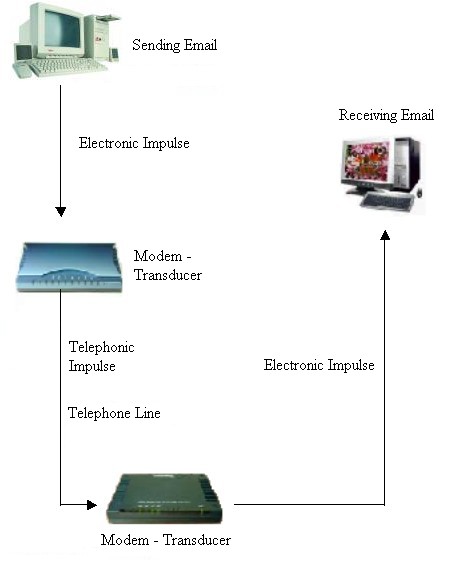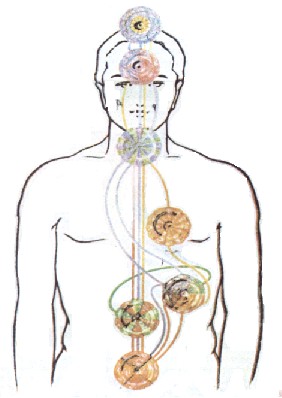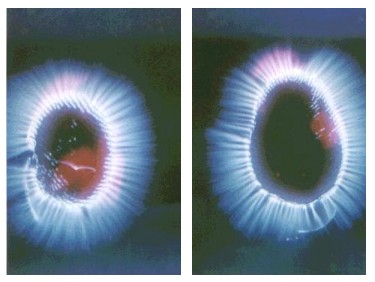

CHAPTER ONE

|
Albert Einstein makes an appearance with a theory that revolutionized science. The thing hat makes engines work, trees grow, men walk and bombs explode was known to scientists as energy. Einstein's theory was simple: "Every object on Earth contains energy, and all matter and all energy are equivalent, so, matter is just energy in static form."
In 1905 Einstein started the research that would lead to the control of atomic energy, 2500 years since Democritus' theory and almost a century since Dalton's first scientific explorations. Einstein was the first scientist to understand that matter was "frozen" energy. But, 40 years after the birth of his theory, atomic science has developed at vertiginous speed. Men of science had discovered that solids, liquids and gases, in other words, everything, was either an element (the simplest substance) or a compound, formed by two or more elements; or a mix, in which two or more elements exist but remain separate, such as sand and water. The "buildong blocks" of elements were single atoms. The building blocks of compounds were molecules, made of two or more atoms linked by electric attraction. |
|
Men find God behind every door the science manages to open.
ALBERT EINSTEIN |

|
Quantum Physics and Awareness of Reality
When we see a tree we say: "Its leaves are green". That is our daily reality. We are not aware that the colour the tree is showing is the one it reflects, the one it "doesn't want", the one it "rejects", because it only allows the rest of the colours of the visible spectrum to enter its molecular structure, those colours are the representation of the range of frequences that solar radiation needs to perform photosynthesis. The colour it shows is only its reafirmation as an species in the enviroment that surrounds it. So, what is reality? the green that we see o the range of frequences represented by the rest of the radiations from the spectrum that allow the tree to continue living? Nowadays, physics are asking themselves is the world we call real is something as concrete as we perceive it,or on the other hand, it is the holographic perception of a great number of elemental particles that order themselves through our human inference. If we cannot perceive reality directly, is there a reality at all?, and particularly, when we cease to perceive it (smell it, taste it, look at it, measure it, evaluate it, etc) does it only continue existing as an intangible sensation that loses shape with time? Then as a result, the questions we must ask are: 1. If I don't recognize a phenomenon, if I am not aware of it as such, the it means it doesn't exist in reality? 2. Does the phenomenon exist only when I perceive it? 3. Is what I perceive the real world? or is it just "my real world"? 4. My real world is just my present moment? 5. Is eternity contained in every instant of my present moment? 6. Can I stop time now, at this very moment, "my instant"? if so 7. Can I become aware of eternity? Aparently these are questions whose answers seem to be too complex. During the past century, in the 30's, Einstein, Rosen and Podolsky faced this problem proclaiming: "There is no reason to wait for a definition of the reality that surround us that could be at least reasonable" Grandes Obras del Pensamiento / Ediciones Atalaya - Printed in Spain - 1993 |
|
How was the world made? and what is it made of?
The first men that tried to find the answer to this question where the greeks, who made an effort to find explanations, according to their logic, to every mistery of nature. Some of them reached strange conclusions. Aproximately in the year 600 B.C., Thales of Miletus, a greek philosopher, stated that water was the substance that made the seas, and every liquid thing, another substance more solid, was what composed harder things, like stones, etc. Little after that, another greek thinker announced that Thales' theory was absurd: it was evident that everything was made of water and air. Another man proposed that the primary element in the world was air, and he was in turn proven wrong by someone that affirmed that objects were made of fire. The situation continued like that, and every theory was succeded by a new one. Years later, Democritus said - Earth, sky, oceans, plants and every human being - were made of very small particles, grouped tightly like bees in a hive. Democritus called this particles "atoms", a greek word that means "indivisible", in other words, that cannot be separated. As we know now Democritus confused atoms with what we nowadays call molecules, but he was headed in the right direction when he thought that they were extremely small. Now we know that molecules are tiny masses made of atoms. Atoms and molecules are so small that is very difficult to imagine their size. John Dalton, an english professor, was the one to discover the key to the question. The explanation was in the concept of atom, Democrito's antique theory. Dalton knew that when several elements were observed in the microscope, crystals in different shapes appeared. Gold crystals always had the same shape, the same happended with copper crystals, but gold and copper crystals were very different form each other. So, he arrived at the conclusion that the atoms of every substance had to have the same characteristics: all the atoms of gold were related, the same happened with the atoms of copper, but the two differen kinds of atoms did not have similarities. Compounds, such as water, had to be regular groups of atoms of different kinds. Water turned out to be a combination of atoms of oxygen and hydrogen. And, said Dalton, the reason why eight grams of oxygen always combine with one gram of hydrogen must be that eight grams of oxygen must have the same number of atoms that one gram of hydrogen. So, Dalton concluded, water is made of an enormous number of double atoms, one atom of hydrogen combined with one atom of oxygen, where this one is eight times more heavy than each of the hydrogen atoms. It was a simple and marvelous idea. Without this impulse in the right direction science would still be stumbling in a path of confusion. Thanks to this theory he formulated, Dalton is considered the founder of the modern atomic theory. Chemists shorten the names of the elements denominating them by their initials, oxygen and hydrogen are known by the letters O and H. Dalton had suggested that water was made of HO, thus expressing an atom of H and one O. Avogadro had discovered that the correct formula was H2O. The grouping of the atoms was more complex than what Dalton had thought. And much later it was discovered that in other substances it was yet even more complex. A molecule of sugar, per example, is composed by 45 atoms: twelve carbon atoms (C), twenty two hydrogen atoms (H) and eleven oxgen atoms (O). Written in scientific form that is : C12H22O11. Such groups of atoms needed a new name and Avogadro named them "molecules" or "little masses". Finally men were starting to discover the answers to the question: "What is the world made of and how is the world made of?" All matter is made of elements and compounds. Elements are made of molecules and atoms. Compounds are made of different kinds of atoms gruped in molecules. In the fifty years following Avogadro's experiments, much was discovered about chemistry and physics. It was discovered that atoms and molecules are always in movement, that they travel a lot in liquids and gases and the merely vibrate in solids. Many new elements were discovered. Each one of course had its own atom, and each had its own weight different from the others. Since Dalton's discoveries, men of science had been wondering about the force that kept the different atoms together in a molecule. Now, it appeared that the force was electricity. For the first time, researchers started to think that atoms could have electrical charges. Atoms themselves are neutral, they don't have positive on negative electrical charge. But inside them both kinds of electricity exist, of course in the same amount. Grandes Obras del Pensamiento - Ediciones Altaya - Printed in Spain - 1993 |
|
Definition from Lexis 22 Encyclopedia :
electromagnetism m. Aspect of physics that studies electric and magnetic phenomena, unified in only one theory that, based in four vectorial equations, stablishes the relationship between the electric and magnetic fields with the electrical charges and currents that act as sources of those fields. These four equations are known as Maxwell equations and they make up a complete description of the electromagnetic field and its interaction with matter. Through them the relationships between electricity and magnetism can be deduced: induction (Lenz's Law), per example, because of which a magnetic field with variable flux creates an electric current and the reverse phenomenon that consists in the creation of a magnetic field by an electric current (electric charges in movement). |
|
Laws of Physics. Electromagnetic theory.
The theories of electricity and electromagnetism were investigated simultaneously towards the end of the eigtheenth century and the beginnings of the nineteenth. In 1831, after Hans Oersted started describing the relationship between electricity and magnetism, he described that electric current that flows in a wire induces a magnetic field around the wire. The frenchman André Marie Ampére followed by the french physicist Dominique François studied the same area in depth and the british scientist Michael Faraday discovered that the movement of a magnet in the proximity of a wire induced in it an electric current; this effect was the opposite of the one discovered by Oersted. The complete unification of these theories was achieved by the british physicist James C. Maxwell, that predicted the existence of electromagnetic waves. |
| Name of the Chakra: | Location | Espinal Ganglian | Sympathetic Plexuso | Subsidiary Plexus |
| Fundamental | In the base of the spine | Sacrum Vertebrae | Sacrum coccyx | |
| Splenetic | over the spleen | first Lumbar Vertebra | Splenetic | |
| Cardiac | over the hear | eight cervical Vertebra | Cardiac | lungs |
| Laryngeal | in the throat | third cervical Vertebra | Pharyngeal | |
| Frontal | over the eyebrows | first cervical Vertebra | Carotid | cranial cavity plexus |
In the central nervous system there is only one chakra named "Crown" chakra, that is in the top center or our head, although it is not related with any of the plexuses of the sympathetic system, it is related to the pineal gland and the pituitary gland and it is involved in the development of this system.
Any person that posseses the gift of /clarivoyance/ can see this wheels or vortices in our etheric body or aura. This body can also be registered by Kirlian cameras.
Figure 3
****See Note on the "Kirlian Effect".
Both this systems we have described attend to two fundamental aspects of our being: the central system attends our mental part, with the Crown Chakra, and the sympathetic system attends to our emotional part and the senses with the other six Chakras.
(See figures 1 and 2)
Up to now we have studied that we exchange vibrations (energy) with the outside. In the next paragraphs we will expand on these concepts.
Through this vibrational exchange we can explain the influence of our human activities in two aspects of our lives.
Per example: when we receive very good or very bad news our cardiac part is shaken, and in some cases cardiac attacks can happen. Haven't we heard people say "my heart feels happy" or "my heart is suffering"? This means that we are exchanging vibrations through our Cardiac Chakra.
Does't our body feel bad, don't we feel pain in the pit of our stomach when we are in a heavy athmosphere or in the presence of a negative or inharmonious person? In these cases we are exchanging vibrations through our umbilical Chakra.
When we emit a thought or idea we are exchanging vibrations through our crown Chakra.
After everything we have studied we can define the following: besides our visible physical body we have a mental body formed by the crown plexus and its respective chakra and the invisible physical vibrations that are part of it, that interact with the mental plane and we also have an astral body or emotional body that is formed by the sympathetic plexuses and their respective chakras and the invisible physical vibrations that are part of it and interact with the astral plane.
The mental plane is where the mental vibrations are located according to their respective vibratory frequence and the astral plane is where the emotional and sensory vibrations are located also according to their frequences.
That is to say we have a visible physical part, body, and an invisible part, spirit or soul formed by the mental, sensory and emotional part.
The soul or spirit has life, spiritual life, and the body also has life, physical life.
|
"We know that there is an infinite, and are ignorant of its nature. As we know it to be false that numbers are finite, it is therefore true that there is an infinity in number. But we do not know what it is. It is false that it is even, it is false that it is odd; for the addition of a unit can make no change in its nature. Yet it is a number, and every number is odd or even (this is certainly true of every finite number). So we may well know that there is a God without knowing what He is. Is there not one substantial truth, seeing there are so many things which are not the truth itself? We know then the existence and nature of the finite, because we also are finite and have extension. We know the existence of the infinite and are ignorant of its nature, because it has extension like us, but not limits like us. But we know neither the existence nor the nature of God, because He has neither extension nor limits. But by faith we know His existence; in glory we shall know His nature. Now, I have already shown that we may well know the existence of a thing, without knowing its nature." BLAISE PASCAL |



The etheric body hat surrounds our physical body can be seen in this photos taken with the Kirlian camera like a vibratory extension of the latter.
1. - Right thumb. -
2. - Left thumb. -
© Copyright - 2005 - All Rights Reserved